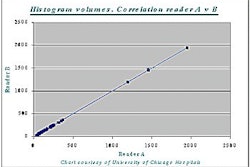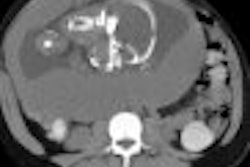VIENNA - In a study of 46 patients with peripheral vascular disease, multislice CT angiography (MSCTA) was found to be particularly well suited to identifying pathology, especially in the distal trifurcation vessels. The research also found that volume-rendering (VR) reconstructions were superior to both maximum intensity projection (MIP) and surface-shaded display (SSD) reconstructions.
In a presentation today at the peripheral vascular sessions of the European Congress of Radiology, Dr. Carlo Catalano from the Institute of Radiology at the University of Rome "La Sapienza" described his team's results with the MSCTA -- an emerging technique now battling with MRA for the hearts and minds of radiologists and vascular specialists.
Dr. Catalano recommended several steps for optimizing the results of MSCTA, starting with patient positioning in the scanner. "The patient has to be positioned feet-first," Catalano said. "All machines allow significant movement when the patient is positioned head-first."
The feet should be secured in position in order to separate the tibia from the fibula and facilitate further reconstruction during processing, he said. "If you rotate the feet you separate the two bones, and you have better visualization of the distal vessels without need of performing further post-processing, in most cases."
In most instances it's enough to use 2.5-mm collimation with a slice width of 3 mm for reconstruction, Catalano said. The reconstruction interval can be evaluated from time to time, he said; reconstruction levels of 1-1.5 mm are often necessary to optimize visualization of the renal arteries, or sometimes the distal vessels. Feed rotation time should be scaled to 3 cm per second, with a rotation time of four seconds, he said.
Regarding contrast administration, Catalano said that 140 ml of contrast at 4 ml/s was sufficient to obtain good opacification of all vessels down to the ankle. That's a relatively high dose of contrast, he acknowledged, but attempts to use less media resulted in poor opacification of trifurcation vessels.
In the study, 43 patients with peripheral arterial disease were examined with MSCTA following bolus administration of 90-140 ml of nonionic contrast. The maximum volume coverage was 120 cm in 30-34 seconds, with coverage from the origin of the renal arteries to the distal vessels. All patients also underwent digital subtraction angiography (DSA).
Because sequential scanning was not available when the scanner was acquired in 1999, the researchers used a fixed delay time of between 25 and 28 seconds, Catalano said. This produced good arterial opacification in all patients.
Following image acquisition, VR rendering reconstructions were performed either on Vital Images’ Vitrea software, or on Siemens’ 3-D software.
"We generally perform volume-rendering techniques in all cases, and we almost never use vessel rotation anymore," he said. Reconstruction time was about 10 minutes per patient.
According to the results, there was excellent correlation of the degree of stenosis with DSA at all levels of stenosis. MSCTA had an overall sensitivity of 97% for the characterization of stenoses, he said, with specificity of 95%. Compared with DSA, MSCTA provided superior characterization of aneurysms and ulcerated plaques in demonstrating parietal thrombus and plaque morphology.
In a separate study of 124 patients using similar MSCTA techniques, the Italian researchers concluded that the VR reconstruction algorithm is superior to both MIP and SSD. Even when bone structures are not segmented, Catalano said, VR reconstructions provide the best diagnostic information, especially in the presence of calcified plaques. Their presence impaired diagnosis in most cases with both MIP and SSD, he said. Most studies at his institution are now reported using axial images and VR reconstructions, he said.
"Multislice CTA is a very powerful tool," he concluded "It's very fast for patients -- the acquisition takes about 40 seconds, and in most of the cases when the patient comes in with a needle in his arm (for contrast), the whole exam takes about two minutes. However, we have to deal with a large amount of data and therefore there is a need for dedicated consoles for 3-D reconstructions."
By Eric Barnes
AuntMinnie.com staff writer
March 5, 2001
Click here to post your comments about this story. Please include the headline of the article in your message.
Copyright © 2001 AuntMinnie.com



















